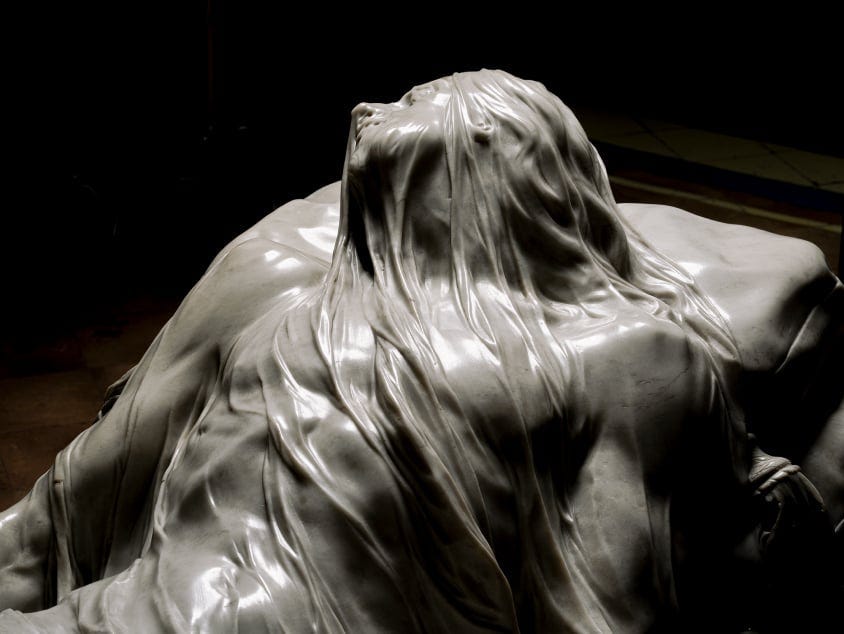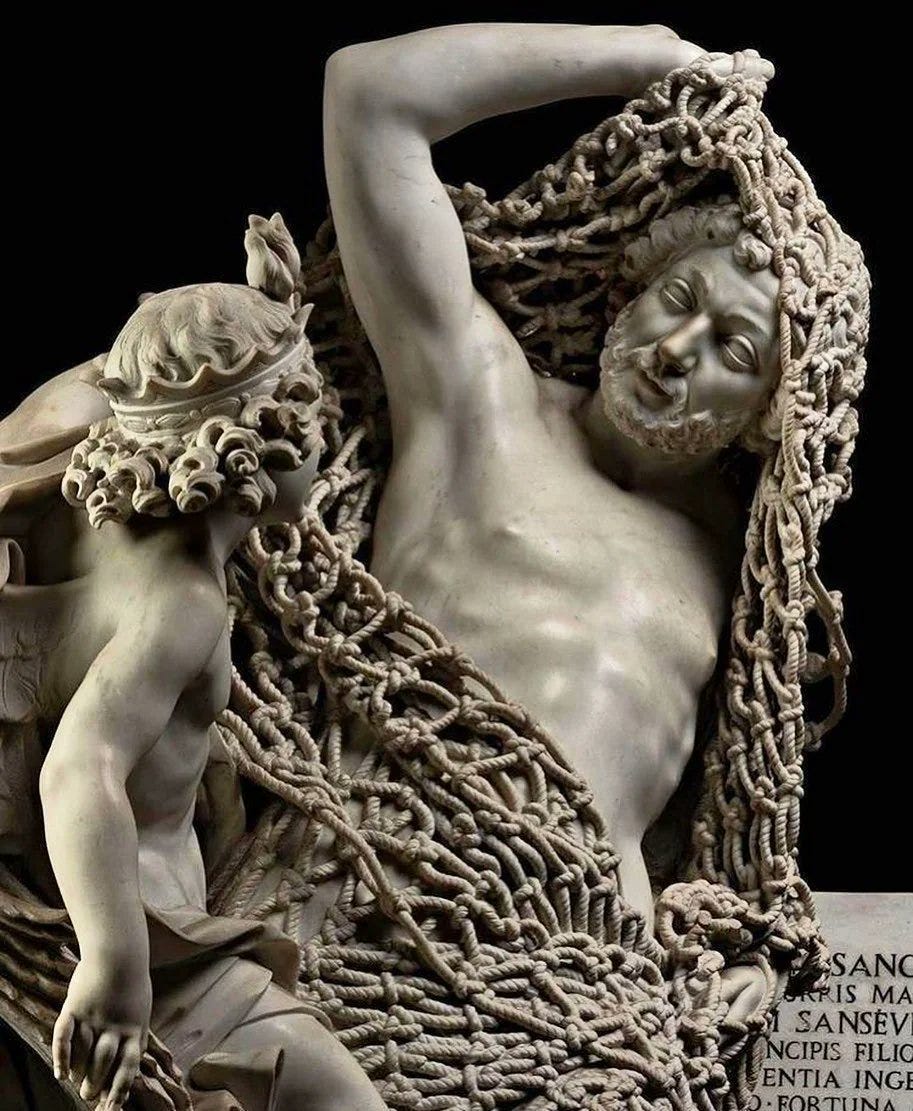The above image captures the work of Francesco Queirolo.
It was completed in 1759, after 7 years of painstaking labour without external assistance. This is the work of only two hands and a single marble stone.
describes the process:Queirolo worked entirely alone on it, without an assistant or even a workshop. Even other sculptors refused to touch the delicate net in case it broke into pieces in their hands.
At the bottom is an inscription from the Bible. Translated, it reads:
“I will break thy chain, the chain of the darkness and long night of which thou art a slave so that thou might not be condemned with this world”
Most people will view the entire sculpture and marvel at a distance. I am more fascinated by the knots. More on this later.
Another marvelous piece of art is The Veiled Christ, completed in 1753 by Giuseppe Sanmartino.

The concept was supposed to be executed by Antonio Corradini, but he died a year before its completion. Sanmartino took over and completed the large-scale version.
I want you to appreciate that a skilled sculptor died, but there was another who was just as gifted and completed what was started.
Below is another historic work of perfection, The Veiled Truth. In the same year of his death, 1752, Antonio Corradini finished this masterpiece.

I bring up these three pieces because I can’t imagine a sculptor this gifted replicating these masterful works. Furthermore, it took Queirolo seven years. The same number of years Jacob took to get Leah, thinking it was Rachel. It then took another seven years. Today, can you name anyone who can wait seven years to get a partner?
Now, what about marble art?
Let me loosen the constraints. Any piece of art. I’ll wait.
Consider the deception online content can have — it is like taking candy. It uses a conserved urge to feed, but doesn’t promise proper nutrition. The online candy is short-lived, hardly satisfying, evidenced by how fast we swipe upward or on the side. Few would stop to appreciate the knots.
But there’s more. I didn’t know the sculptors. I had to look them up. Why? I needed some context. The first context is always pinned to the creator. I would have appreciated the art without the artist. Indeed, I did.
The artists, however, are related. They hail from the same period. Few can execute such iconic pieces. In short, nobody had swagger like them.
AI’s stainless art
The artist, too, introduces a stain. Claire Dederer describes every artist in today’s world as having a stain. When you think of Kanye West, you have something to say about him. If it’s Taylor Swift, you can’t think of any other billionaire who made it to that coveted list exclusively from music.
Kendrick and Drake have their stains, and so does J. Cole. Celine Dion with her condition and Whitney Houston with her unhealthy relationship. I bias my list to music to show that any form of creation has a stain that the artist imprints.
I could think of the veiled pieces in Naples without a care for who made them. It’s similar to what writers do. Once your work is published, the interpretation is no longer yours, it’s the reader’s.
The poet is hardly ever around to interpret the work for the reader. It moves in phases. The work of art first transitions from its abstract form within the creator to the concrete creation. It then transitions again from crystallized creation into its abstract form when exposed to its audience.
Art is interaction.
The transcendent feeling when in the presence of a breathtaking piece is the act of creation, this time around, for and by the beholder.
Before the internet, art could be obscure. A wide chasm could exist between the artist and their product when they were alive, and even more when they died. It was so wide I didn’t realize that I savoured the art absent the artist.
With the internet, this is now close to impossible, unless the artist doesn’t want to be known, like a pen name or crypto.
The artist stains the art.
Now you can’t think about a Kanye West production without Kanye. No legacy without the legend. Thanks to connectivity, it’s impossible to imagine the art unstained. Kanye raps:
My attitude is tattooed
That means it’s permanent so I guess I should address it, huh?
Is that a good thing? I’ll let you decide what to make of it. What I can speak about is the value of the stain in the future.
Are you a robot?
You can pay for school but you can’t buy class
— Jay-Z
CAPTCHA codes, matching pictures with the questions, and correctly fitting online jigsaw puzzles. These are the questions machines ask us to confirm our humanity.
A robot cannot make a veiled sculpture. Heck, I doubt any human being today can make such masterful artwork. However, even in our disabilities, the lineage remains strictly human. No machine crafted the historic pieces.
Are you a robot? If you or a computer were to pose the same question to the three artists, they may look at you with wonder or disdain. How dare you question their humanity!
I may be too dumb to know why websites need to know if I’m human or not. Don’t they want engagement? Or do they need to know that it’s not bots who get to click ad-polluted pages?
AI doesn’t want the art. It wants the artist.
The recent Ghiblification of the internet confirmed this. Anyone who could change their profile picture converted it. Ghibli was the hottest thing that week. Or was it for two weeks? I doubt it extended past a month.
The world is done with that phase. That should alarm you.
The art was appealing, up until it wasn’t. Everyone has now moved on. The chasm created was similar to that in the 18th century. There was art, and most people didn’t know who the artist was.
They relished OpenAI’s recent feature. Then the wave died. Now the art has lost its lustre.
Two ways to look at this. The first is the ability of AI to erode the attractiveness of art.
Art connects us. It reaches beyond the boundaries of its aesthetic appeal to bridge a world for us to interact with it. This bridge is stable enough to let anyone interested to cross it.
When robbed of its appeal, the bridge collapses. We don’t see the knots. That’s worrying.
The other way to view this is through the stain. The art could have survived 300 years ago without most people knowing about the artist. Today, as AI consumes more artwork and fills the internet with alternate forms, it loses that transcendent touch.
But the stain remains.
We still know Hayao Miyazaki. His work lives after the death of the AI-Ghibli craze. It’s not Ghibli, it’s AI-Ghibli. There’s a difference. The former is like one’s voice, the latter is autotune. One has character, the other lacks it.
I’m compelled to think that the AI-Ghibli spread because of the stain the artist left on their artwork. The stain has value. The stain is what websites ask when you visit their pages:
Are you a robot?
No doubt, AI has changed our realities. No previous human civilizations have had the chance to build futures with intelligent machines. The future is teeming with potential.
But as AI improves productivity, what we should cling to, I suggest, is not the product, but the stain.
The stain reminds. Kafkaesque work reminds us of Kafka. The stain persists through death.
I am equally compelled by what AI can do. It lacks the macroscopic stain we can see from the veiled sculptures, but it takes us back to their time, when the art could be appreciated without the artist.
Can the art compel without its stain?
Stains impurify. But the kind of stain the artist imbues into their work glorifies it. Indelible stains. The stain, you could say, is the bridge. Can AI create such a bridge? Can we see the entrancing knots throughout their work?
What I’m trying to say is…
I started this piece with The Release from Deception.
Now I pose the question: can we free ourselves from the deception of art that lacks a defined human artist? Art that lacks a stain? Or am I deceived into thinking we need freeing?
Where lies the deception? Is it in the potential for changing our lives by imagining the elevated projections of AI on our productivity?
Or should we simply forget the knots?
I suggest that we should knot.
This song inspired some of the lines used in this article. Source — YouTube


